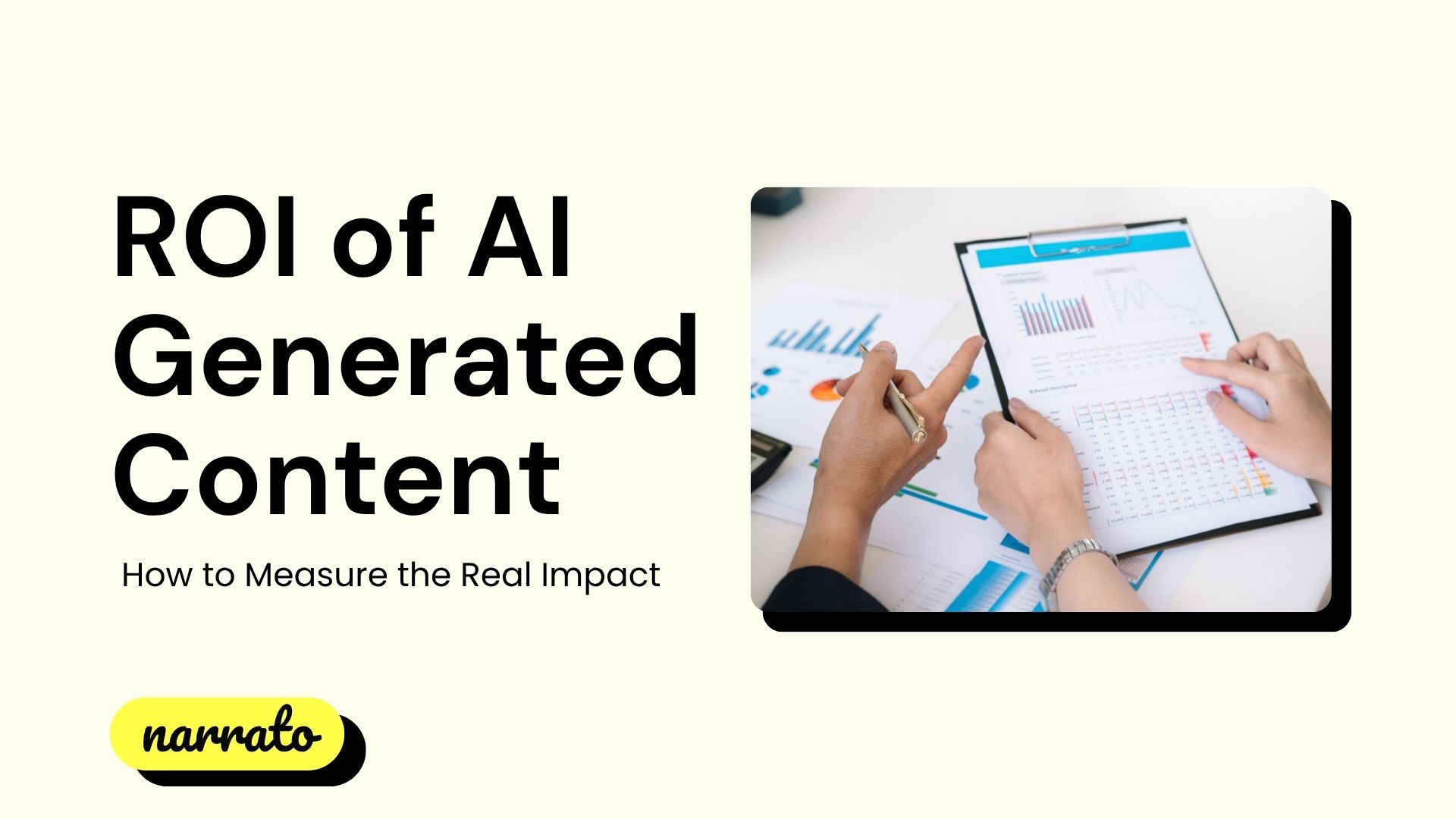In an era where AI-driven content creation is becoming the norm, businesses face a significant challenge: measuring the real Return on Investment (ROI) of AI-generated content. Why does this matter? With 92% of global businesses planning to ramp up AI investments over the next few years, according to a recent McKinsey report, understanding the ROI becomes crucial to ensure these investments translate into tangible business benefits.
Unfortunately, traditional ROI models fall short because they mainly focus on simple task automation and cost savings, missing the broader picture of business value that AI tools can bring. From enhancing employee productivity to accelerating time-to-market and optimizing customer engagement, AI-generated content offers multifaceted benefits that redefine conventional ROI metrics. This blog explores effective strategies to measure these benefits, ensuring that your business not only keeps pace with technological advancement but reaps the rewards of AI’s transformative potential.
Understanding AI-generated content ROI
Metrics for evaluating ROI of AI-generated content
Tools and techniques for measuring ROI

Understanding AI-generated content ROI
So, how does one measure the return on investment (ROI) for AI-generated content effectively? To navigate this, it’s essential to have a foundational understanding of ROI and how it applies in this context.
Comparison with traditional ROI models
Traditional ROI models primarily focus on straightforward metrics such as cost savings and automation efficiencies. These models are largely insufficient when applied to AI-generated content, which often delivers complex and multifaceted business impacts. While traditional models might ask, “How many hours did AI save us?”, a more relevant question in today’s AI landscape might be, “How much business value did AI-generated content create?”
Traditional content performance metrics like clicks and impressions may give you some idea of how AI is improving your search performance, but they fail to paint the complete picture as well.
Agentic AI, which functions as an extension of the human team, demands an evolution in ROI assessment. This type of AI not only performs tasks but also understands business objectives, plans, and executes strategies. It’s akin to comparing a simple tool to a whole team of experts working towards a common goal. Thus, measuring AI-generated content’s ROI requires moving beyond the basic cost and performance paradigms to encompass business agility, creativity, and customer engagement, which the technology facilitates.
Importance of accurate ROI measurement
Without precise metrics, it becomes challenging to determine the efficacy of AI investments and their alignment with broader business objectives. According to a 2025 study, about 95% of AI initiatives fail to deliver the expected financial returns, largely because organizations are using outdated ROI frameworks that do not capture the nuanced capabilities of AI-generated content.
Businesses aim to pursue growth-oriented strategies rather than just cost-cutting. Hence, a precise ROI measurement is essential to identify key areas where AI-generated content adds value. By doing so, companies can effectively align their AI investments with broader strategic goals, ensuring sustained competitive advantage.
Metrics for evaluating ROI of AI-generated content
To unlock the full potential of AI-generated content, it is crucial to employ a multi-faceted approach to metrics, incorporating various dimensions to capture its overall impact. For instance, high conversion rates and improved Customer Acquisition Costs (CAC) indicate AI’s impact on driving sales. Additionally, Customer Lifetime Value (CLV) provides insight into the long-term value AI contributes by nurturing and sustaining customer relationships.
Let’s take a look at some of the most relevant and crucial metrics that you need to consider when calculating the ROI of AI in content creation.
Key performance indicators (KPIs)
KPIs serve as the compass for assessing the success of AI-generated content. They encompass engagement metrics, conversion rates, and metrics that align directly with business objectives.
We can break down these performance metrics as follows.
Content performance metrics
- Engagement rates – Click-through rates, time on page, bounce rates, social shares
- SEO performance – Organic traffic, keyword rankings, and domain authority changes
- Conversion rates – Lead generation, sales, and sign-ups attributed to AI content
- Content quality scores – Readability scores, originality percentages, brand voice alignment
Quality & risk metrics
- Edit/revision rate – Percentage of AI content requiring significant human editing
- Accuracy rate – Fact-checking results and error frequency
- Brand safety incidents – Off-brand or problematic content that needed correction
- Audience sentiment – Feedback and satisfaction with AI-generated content
KPIs also extend across operational metrics, examining how AI influences employee productivity and workflow efficiency. Successful implementation often results in increased speed-to-market for marketing campaigns and streamlined content production timelines.
Model quality and system performance metrics
Model quality helps measure how well your AI-generated content systems deliver accurate and relevant outcomes. This can be done through model-based metrics like coherence, safety, fluency, and groundedness. These metrics assess responses based on criteria such as language mastery and adherence to instructions, ensuring the generated content meets high-quality standards.
You can judge gen AI model quality using some or all of the following metrics.
Accuracy & correctness
- Factual accuracy rate – Percentage of verifiable claims that are correct
- Hallucination frequency – Rate of fabricated information or false claims
- Citation accuracy – Correctness of references and sources when provided
- Domain-specific accuracy – Performance on specialized topics or terminology
Content quality
- Coherence scores – Logical flow and consistency throughout content
- Relevance to prompt – How well the output matches the input requirements
- Readability metrics – Flesch-Kincaid, Gunning Fog Index, grade level
- Originality/plagiarism scores – Uniqueness vs. existing content
- Tone consistency – Alignment with brand voice guidelines
Language quality
- Grammar and syntax errors – Mistakes per 1,000 words
- Vocabulary appropriateness – Right level for target audience
- Style consistency – Adherence to style guides
AI platforms like Narrato and Typeface ensure high standards of model quality and output quality. With strong brand governance features and built-in content analysis and scoring systems, these platforms ensure that your content maintains consistent quality, style, and compliance even when generated with AI.
System performance metrics focus on the operational health of AI systems. These encompass deployment metrics such as the number of active models and the percentage of automated workflows. Furthermore, reliability and responsiveness metrics like uptime, error rates, and model latency shed light on system efficacy, helping businesses identify operational bottlenecks and performance improvements.
Here are some useful metrics to consider.
Speed & efficiency
- Latency – Time from prompt to first token / complete response
- Throughput – Requests processed per second/minute
- Token generation speed – Tokens per second
- Queue time – Wait time during high demand
Reliability
- Uptime/availability – System availability percentage (target: 99.9%+)
- Error rate – Failed requests as percentage of total
- Timeout frequency – Requests exceeding time limits
- Mean time between failures (MTBF)
- Mean time to recovery (MTTR)
User experience
- User satisfaction scores – Direct feedback from content consumers
- Bounce rate correlation – How AI content affects site engagement
- Task completion rate – For instructional or functional content


Business operational and financial impact metrics
Operational metrics evaluate the real-world impact of AI content systems on business operations. They include customer acquisition costs and lifetime value, which indicate how AI enhances lead generation and qualification. Revenue-related metrics like revenue per visit provide insights into how AI affects sales and customer retention.
Business impact metrics
- Revenue attribution – Direct sales or pipeline influenced by AI content
- Customer acquisition cost (CAC) – Cost to acquire customers through AI content channels
- Lifetime value (LTV) – Value of customers acquired via AI content
- Marketing qualified leads (MQLs) – Leads generated from AI content campaigns
Financial impact metrics translate operational enhancements into measurable financial gains. By evaluating AI-driven cost savings, such as reduced hiring and training expenses, companies can compute the financial gains directly attributed to AI applications. Furthermore, AI’s role in promoting business agility, through rapid content production or streamlined processes, translates into significant financial returns, underpinning long-term growth.
Cost efficiency metrics
- Cost per piece of content – Compare AI vs. human-created content costs (including tool subscriptions, editing time, and overhead)
- Time savings – Hours saved in content production, allowing reallocation to strategic work
- Production velocity – Volume of content produced per time period
By tracking these comprehensive metrics, businesses can better quantify the true value AI-generated content delivers, ensuring their investments drive robust, customer-centric growth and innovation.
Tools and techniques for measuring ROI
So, how do you accurately measure the win rates and value that AI brings to your business operations and creative workflows? Let’s dive into some of the key tools and techniques that can help with ROI calculation.
Attribution models and A/B testing
When it comes to AI-generated content, one essential technique for measuring ROI is implementing attribution models. Attribution models help you understand which parts of your marketing efforts are contributing most to your business outcomes.
By assigning credit to different content touchpoints in the customer journey, you gain a clearer picture of your content’s effectiveness. This understanding is fundamental for calculating ROI as it aligns content performance with your business goals, giving you a better idea of where and what type of AI-generated content works best.
Moreover, A/B testing plays a pivotal role in this context. Why? A/B testing allows you to compare two versions of content to see which performs better in terms of conversion rates and engagement. For instance, you might use A/B testing to determine whether AI-generated email subject lines or social media copy perform better than human-generated alternatives. The insights gained from these tests can guide your content strategy decisions, optimizing for greater ROI.
By continuously testing and refining your AI-generated content, you not only enhance content performance but also position your business for better content optimization, decision-making, and growth.
Competitive benchmarking
Understanding how your AI-generated content is performing compared to competitors is another critical aspect of ROI measurement. This is where competitive benchmarking comes into play. Competitive benchmarking offers a perspective on industry standards and helps set performance targets that are realistic and motivating.
To undertake competitive benchmarking, you first need to identify key performance indicators (KPIs) that align with your business goals. This might include metrics like conversion rates, click-through rates (CTR), and customer engagement levels. Using these metrics, you can assess where your AI content stands relative to competitors in the industry.
More importantly, competitive benchmarking helps you recognize market trends, areas where your competitors might be excelling, and opportunities for improvement in your own strategies. It provides actionable insights that drive better content creation and delivery, directly impacting your bottom line.
Wrapping up
Understanding how to measure the real ROI of AI-generated content is imperative for businesses aiming to stay competitive. While traditional ROI metrics like cost savings and time efficiency have their place, the shift towards AI demands a broader perspective that accounts for factors such as enhanced creativity, business agility, and innovation.
AI-generated content is the future of content marketing. It has the potential to transform your business operations and elevate your marketing strategies to new heights. But to get real value out of your AI content creation strategy, you must start tracking KPIs that matter.












